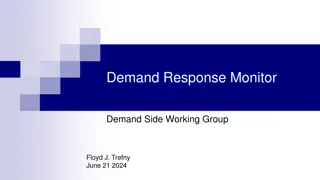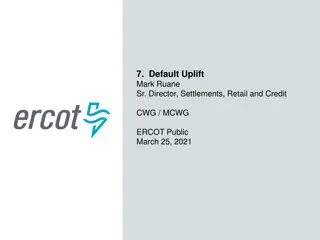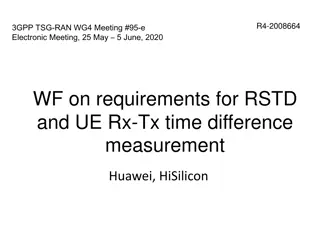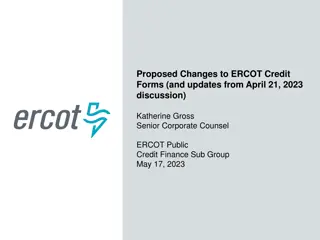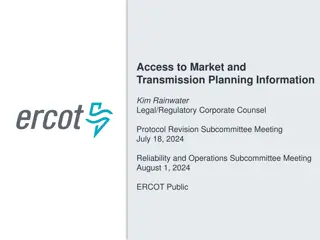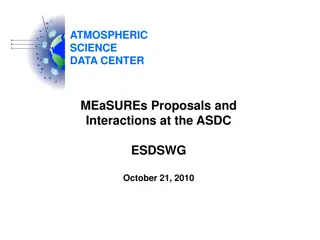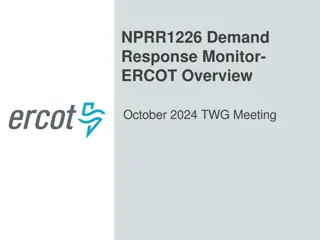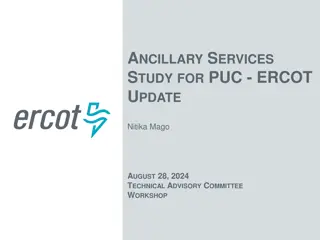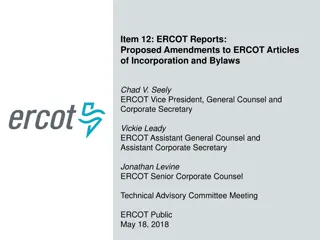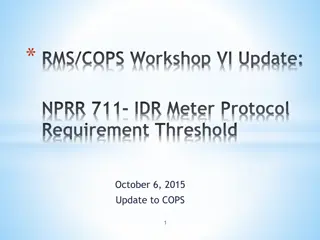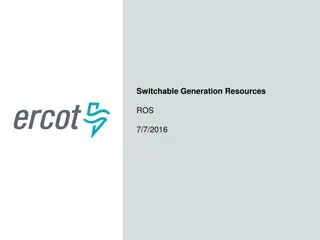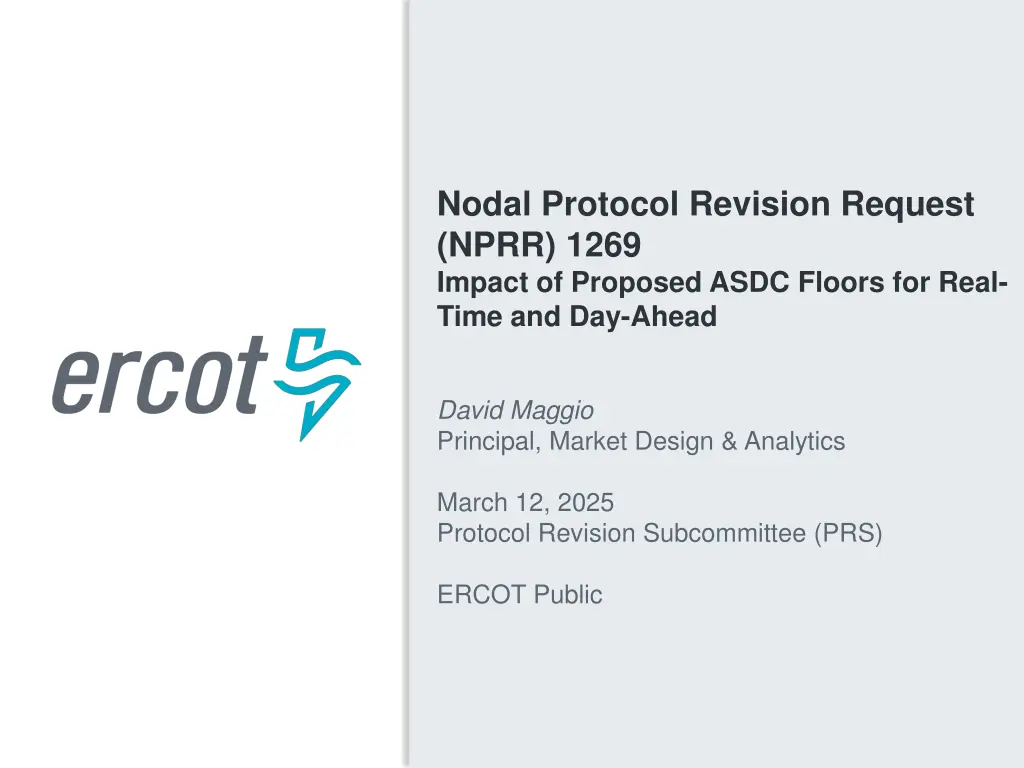
ERCOT NPRR 1269 Impact: ASDC Floors for Real-Time and Day-Ahead Analysis
"ERCOT evaluates the impact of proposed ASDC floors on Real-Time and Day-Ahead markets, emphasizing the need for pricing adjustments to incentivize resource commitment for Ancillary Services."
Download Presentation

Please find below an Image/Link to download the presentation.
The content on the website is provided AS IS for your information and personal use only. It may not be sold, licensed, or shared on other websites without obtaining consent from the author. If you encounter any issues during the download, it is possible that the publisher has removed the file from their server.
You are allowed to download the files provided on this website for personal or commercial use, subject to the condition that they are used lawfully. All files are the property of their respective owners.
The content on the website is provided AS IS for your information and personal use only. It may not be sold, licensed, or shared on other websites without obtaining consent from the author.
E N D
Presentation Transcript
Nodal Protocol Revision Request (NPRR) 1269 Impact of Proposed ASDC Floors for Real- Time and Day-Ahead David Maggio Principal, Market Design & Analytics March 12, 2025 Protocol Revision Subcommittee (PRS) ERCOT Public
Introduction On March 3rd, ERCOT filed comments to NPRR1269 to codify specific numbers that were previously left as variables, while analysis and discussion at the Real-Time Co-optimization plus Batteries Task Force (RTCBTF) was ongoing. The comments were specific to the Ancillary Service Demand Curves (ASDCs) for Reliability Unit Commitment (RUC) and the Ancillary Service proxy offer floor parameters. On March 4th, TCPA filed comments to NPRR1269 to take the ASDC floor for RUC and apply it to the Day-Ahead and Real-Time Markets (DAM and RTM). This concept had been raised at the RTCBTF by market participants but had not yet been captured in proposed NPRR1269 language. This presentation is intended to provide ERCOT s perspective and analysis on potential impacts to the RTM in having the ASDC floor concept applied. 2 PUBLIC
ERCOTs Perspective on the Concept of TCPAs Comments ERCOT is generally in favor in this concept moving forward: In light of Ancillary Service quantities we see today and in the near- term, there is a legitimate concern that DAM and RTM pricing may be insufficient to incent self-commitment of Resources for the tail amounts of Ancillary Services and may lead to increased RUC instructions, even when there is sufficient Resource capability otherwise. $15 per MW per hour (the ASDC floor proposed by ERCOT for RUC) is a relatively modest ASDC price for smaller levels of shortages and well below the minimum prices for Regulation Service (Reg) and Responsive Reserve Service (RRS) already included in NPRR1268. 3 PUBLIC
ERCOTs Perspective on the Concept of TCPAs Comments cont. The distinction that this is a floor on the ASDCs and not a floor on the price for Ancillary Services is important. To the degree there are sufficient Ancillary Service offers and Resource capability, those offers would be setting the price, not the ASDCs. This is equivalent to what is seen in DAM today where current penalty prices are ~$5,000 per MW per hour, although that is almost never the clearing price. The deeper concern for those opposed to the concept seems to be the quantities that feed into the Ancillary Service Plan generally. A more thorough review of the process for determining these quantities is already underway with the development of a full statistical analysis tool and the consideration of closer to the Operating Day Ancillary Service quantity determination. If there are Ancillary Service quantity reductions, this concept will automatically adjust to account for that. 4 PUBLIC
Ancillary Service Plan for 2025 As it stands today, the Aggregate Operating Reserve Demand Curve (AORDC) is guaranteed to go to $0 per MW per hour at 10 GW of Ancillary Services and goes to pennies per MW per hour well before that. Summed 2025 Ancillary Service Plan by Hour and Month in MW (Excluding Reg-Down) While a floor will not affect the ASDCs at all in some hours, in others it may be the only means for procuring the Ancillary Service Plan, even if there is more than sufficient Resource capability that would otherwise be available. 5 PUBLIC
Analysis Framework for RTM Impacts Scenarios Evaluated Case 1: Real-Time Co-optimization (RTC) without ASDC floors using max(min(2000, 95% )-0.01,0) for proxy floors Case 2: RTC with $15 per MW per hour ASDC floors using (min(2000, 95% ) 0.01) for proxy floors Case 3 (for prices): Derived from case 1 and 2 outputs to explicitly isolate the impacts of the ASDC floor and ignore impacts from proxy offer floors and the lack of Ancillary Service Offer data available for the simulations If the ASDC floor sets the price for ERCOT Contingency Reserve Service (ECRS) or Non-Spinning Reserve Service (NSpin) in case 2, use the case 2 prices. Otherwise use the case 1 prices. Dataset (~3,800 intervals across 5 months and 154 Operating Days) Jan. 24 (hours ending 18-19) Apr. 24 (hours ending 20-21) May 24 (hours ending 13-14) Aug. 24 (hours ending 20-21) Oct. 24 (hours ending 20-21) Metrics Count of intervals where the ASDC floor is setting the price Average price of Ancillary Services and energy Average quantity of Ancillary Service procurements and shortages Simulations of historical days are hampered by a lack of existing Real-Time Ancillary Service Offers. While we don t expect this to be a typical case in practice, this means that the simulation results can be dominated by proxy offers. Combined, cases 2 and 3 attempt to address this and provide the range of expected pricing outcomes with actual outcomes falling in between and being dependent on offer behavior. 6 PUBLIC
Illustration of ASDCs with a Floor (ECRS and NSpin) ECRS Plan: 2,559 MW NSpin Plan: 1,942 MW Aug. '24 Hour Ending 20 Aug. '24 Hour Ending 20 6,000 100 $/MW per hour $/MW per hour 5,000 80 4,000 60 3,000 40 2,000 20 1,000 - - - 1,000 2,000 MW 3,000 4,000 - 1,000 2,000 MW 3,000 4,000 ECRS - No Floor ECRS - w/ Floor NSpin - No Floor NSpin - w/ Floor ECRS - No Floor ECRS - w/ Floor NSpin - No Floor NSpin - w/ Floor ECRS Plan: 2,514 MW NSpin Plan: 4,482 MW May '24 Hour Ending 14 May '24 Hour Ending 14 6,000 100 $/MW per hour $/MW per hour 5,000 80 4,000 60 3,000 40 2,000 20 1,000 - - - 1,000 2,000 3,000 4,000 5,000 MW - 1,000 2,000 3,000 4,000 5,000 MW ECRS - No Floor ECRS - w/ Floor NSpin - No Floor NSpin - w/ Floor ECRS - No Floor ECRS - w/ Floor NSpin - No Floor NSpin - w/ Floor 7 PUBLIC
Illustration of ASDCs with a Floor (ECRS and NSpin) cont. Oct. '24 Hour Ending 21 ECRS Plan: 1,555 MW NSpin Plan: 2,403 MW Oct. '24 Hour Ending 21 6,000 500 $/MW per hour $/MW per hour 5,000 400 4,000 300 3,000 200 2,000 100 1,000 - - - 2,000 4,000 6,000 - 2,000 4,000 6,000 MW MW ECRS - No Floor ECRS - w/ Floor NSpin - No Floor NSpin - w/ Floor ECRS - No Floor ECRS - w/ Floor NSpin - No Floor NSpin - w/ Floor The actual effects of a floor on the ASDC shape will vary by month and hour. For some hours, like this October period, there is no impact to the ASDCs whatsoever. For others, like the May period on the previous slide, the floor creates a long tail to encourage self-commitment to meet the Ancillary Service Plan when true scarcity does not otherwise exist. 8 PUBLIC
Average Ancillary Service Shortages by Month Studied Measured Relative to the Ancillary Service Plan 01 2024 04 2024 05 2024 08 2024 10 2024 0 ecrs 100 0 nspin 100 0 regup 100 0 rrs 100 Impacts were limited to ECRS and NSpin and for intervals where shortages were relatively marginal, i.e., not deeper levels of scarcity in which prices were further up the ASDCs. This improved average shortages overall. The ASDC floors infrequently set the price (1.5% of the intervals studied). For case 3, shortage amounts and time that the ASDC floor is setting the price would effectively be equivalent to case 2. Count of Intervals w/ Floor Setting Price Month ECRS NSpin 0 5 Jan. 24 0 3 Apr. 24 10 0 May 24 25 7 Aug. 24 1 10 Oct. 24 9 PUBLIC
Average Ancillary Service Procurement by Month Studied 01 2024 04 2024 05 2024 08 2024 10 2024 4,000 ecrs 2,000 0 4,000 nspin 2,000 0 4,000 regup 2,000 0 4,000 rrs 2,000 0 As noted with the shortage data on the previous slide, impacts to Ancillary Service procurement were limited to lower levels of shortages. However, the floor increased average procurement quantities generally. 10 PUBLIC
Average Real-Time Prices by Month Studied Ancillary Service Prices 01 2024 04 2024 05 2024 08 2024 10 2024 100 ecrs 50 0 100 nspin 50 0 100 regup 50 0 100 rrs 50 0 Energy Prices 01 2024 04 2024 05 2024 08 2024 10 2024 120 100 80 0 40 20 0 With the lack of Real-Time Ancillary Service offers and the dependency on proxies for simulation, case 2 provides a conservative evaluation of potential price changes. Case 3 numbers provide the other end of the range of outcomes. Even considering case 2 outcomes, ECRS and NSpin prices are in alignment with other Ancillary Service and historical prices and energy price impacts are minimal. 11 PUBLIC
Conclusions There is a legitimate concern that DAM and RTM pricing may be insufficient to incent self-commitment of Resources for the tail amounts of Ancillary Services and lead to increased RUC instructions, even when there is sufficient Resource capability otherwise. $15 per MW per hour is a relatively modest ASDC price for smaller levels of shortages and the impact to average overall prices is minimal ($0.56/MWh, or 0.8%, for case 2 for energy prices). The floors also help to lessen smaller levels of Ancillary Service shortages. For those more concerned about the Ancillary Service Plan quantities, a more thorough review of the process for determining these quantities is already underway. Any ASDC floor that is applied would automatically adjust and have less effect on outcomes overall. 12 PUBLIC



